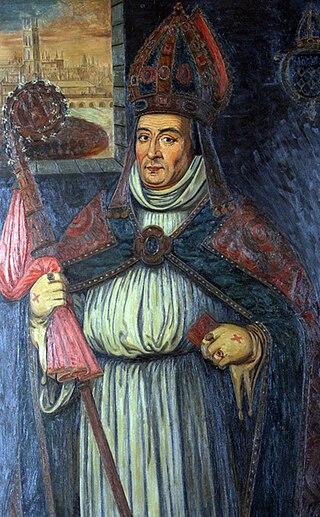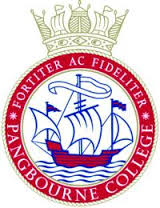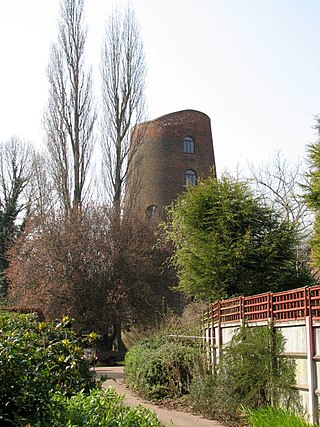
Wingrave is a village in Buckinghamshire, England, about four miles north east of Aylesbury and three miles south west of Wing.

Lancing College is a public school for pupils aged 13–18 in southern England, UK. The school is located in West Sussex, east of Worthing near the village of Lancing, on the south coast of England. Lancing was founded in 1848 by Nathaniel Woodard and educates c. 600 pupils between the ages of 13 and 18; the co-educational ratio is c. 60:40 boys to girls. Girls were admitted beginning in 1971. The first co-ed, Saints’ House, was established in September 2018, bringing the total number of Houses to 10. There are 5 male houses and 4 female houses.

William Waynflete, born William Patten, was Headmaster of Winchester College (1429–1441), Provost of Eton College (1442–1447), Bishop of Winchester (1447–1486) and Lord Chancellor of England (1456–1460). He founded Magdalen College, Oxford, and three subsidiary schools, namely Magdalen College School in Oxford, Magdalen College School, Brackley in Northamptonshire and Wainfleet All Saints in Lincolnshire.

Bradfield College, formally St Andrew's College, Bradfield, is a public school for pupils aged 13–18, located in the small village of Bradfield in the English county of Berkshire. It is noted for its open-air Greek theatre and its triennial Greek Play.

Pangbourne College is a co-educational private day and boarding school located in Pangbourne, Berkshire. It is set in 230 acres, on a hill south-west of the village, in an Area of Outstanding Natural Beauty.

Tudor Grange Academy is a co-educational Academy and technology college located in Solihull, West Midlands, England. Formerly known as Tudor Grange Grammar School and Tudor Grange Secondary School. It was originally a boys' grammar school for around 650 boys. A girls grammar school was built later and both original schools now form part of the current academy.

Northleach is a market town and former civil parish, now in parish Northleach with Eastington, in the Cotswold district, in Gloucestershire, England. The town is in the valley of the River Leach in the Cotswolds, about 10 miles (16 km) northeast of Cirencester and 11 miles (18 km) east-southeast of Cheltenham. The 2011 Census recorded the parish's population as 1,854, the same as Northleach built-up-area.

Bloxham School, also called All Saints' School, is a private co-educational day and boarding school of the British public school tradition, located in the village of Bloxham, three miles (5 km) from the town of Banbury in Oxfordshire, England. The present school was founded in 1860 by Philip Reginald Egerton and has since become a member of the Woodard Corporation. The current headmaster is Paul Sanderson, who took over from Mark Allbrook in 2013. The school has approximately 515 pupils.

Worksop College is a British co-educational private school for both boarding and day pupils aged 13 to 18, in Worksop. It sits at the northern edge of Sherwood Forest, in Nottinghamshire, England. Founded by Nathaniel Woodard in 1890, the school is a member of the Woodard Corporation and Headmasters' and Headmistresses' Conference, and has a strong Anglo-Catholic tradition.

Ardingly College is a fee-charging boarding and day school in the English public school tradition located near Ardingly, West Sussex, England. The school is a member of the Headmasters' and Headmistresses' Conference and of the Woodard Corporation of independent schools and as such has a strong Anglo-Catholic tradition. It was originally a boarding school for boys, and became fully co-educational in 1982.

Denstone College is a mixed, private, boarding and day school in Denstone, Uttoxeter, Staffordshire, England. It is a Woodard School, having been founded by Nathaniel Woodard, and so Christian traditions are practised as part of College life. It is a member of the Headmasters' and Headmistresses' Conference.
Kent College, Canterbury is a co-educational private school for boarding and day pupils between the ages of 3 months and 18 years. It was founded in 1885, and is a member of the Headmasters' and Headmistresses' Conference. Originally established as a boys' public school, it admitted girls into the sixth form in 1973 and since 1975 it has been fully co-educational.
Woodard Schools is a group of Anglican schools affiliated to the Woodard Corporation which has its origin in the work of Nathaniel Woodard, a Church of England priest in the Anglo-Catholic tradition.

Clayesmore School is an independent school for boys and girls, aged 8 – 18 years, in the village of Iwerne Minster, Dorset, England. It is both a day and boarding school and is a member of The Headmasters' and Headmistresses' Conference (HMC).

Sir Ernest George was a British architect, landscape and architectural watercolourist, and etcher.

Cawston is a village and civil parish in the Broadland district of Norfolk, England. The village is approximately 11 miles (18 km) north of Norwich on the B1145 road, a route which runs between King's Lynn and Mundesley. Nearby towns are Reepham and Aylsham.
Stafford Grammar School is a mixed independent day school at Burton Manor, located on the outskirts of Stafford, the county town of Staffordshire. Founded in 1982, the school inhabits a building built by the Victorian architect Augustus Pugin.

Cawston Road Mill is a tower mill at Aylsham, Norfolk, England, which has been truncated and converted for use as a holiday home.

Sompting Abbotts Preparatory School is a historic West Sussex independent school in Sompting, near Worthing and Steyning. It educates children of both sexes aged 2 to 13. The school sits in parkland of 30 acres, which includes woodland, chalk grassland slopes and a pond.



















